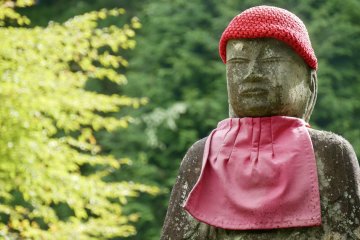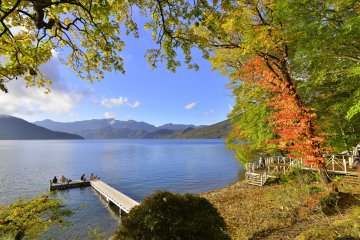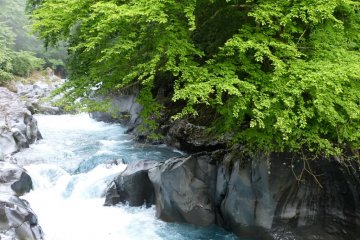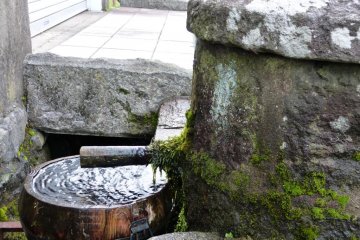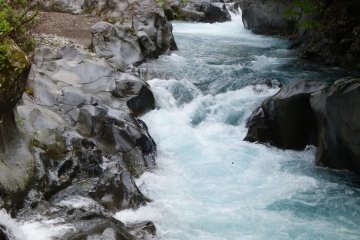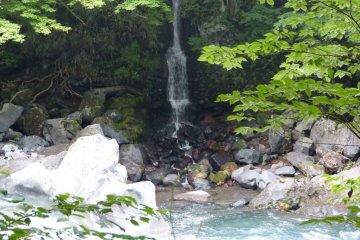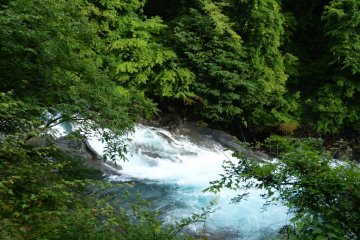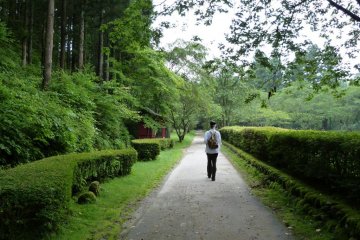There is a great, short walking course near the Tosho-gu World Heritage Site that leads to the deep Kanman-gafuchi gulch on the Daiya River. It starts from the Nishi-sando Bus Stop and takes about 60 minutes to complete.
Takumi-cho (Craftsmen’s town)
When you get off the bus and first begin to walk this course, you will pass through a place called Takumi-cho. Takumi-cho was once a residential area where many craftsmen who were working at Tosho-gu Shrine lived. The craftsmen living there today are the recipients of special skills passed down from their fathers, grandfathers and great-grandfathers. Here, you will find old elegant Japanese houses and lines of stone basins (cisterns) along the streets. These cisterns called Ishi-masu are hollowed out from stone. They are connected with stone runners from a nearby spring and store fresh water. The water is very cold in the hot summer, and warm in the chilly winter.
Kanman-ga-fuchi Gulch
The Daiya River runs from Chuzen-ji Lake and passes through Kegon-no-taki Falls, then goes down through the Nikko city area. Chuzenji-Lake is 1270m above sea level, under Kegon-no-taki Falls is 1170m and JR Nikko Station is only 530m. So, the big drop in altitude creates a swift current in the city area. Kanman-ga-fuchi is such a place, with a strong torrent of water surging through.
In 1654 priest Kohkai (who was one of the leading disciples of Tokugawa Ieyasu’s spiritual advisor Tenkai) established Jiun-ji Temple near this gulch in the river and set up a prayer platform on a rock. There used to be a statue of the god Fudo on the other side of the river and when priests prayed to Fudo, they heard a mantra like sound coming from the river. The sound they heard was “Kahhhhn-mahhhhn…….Kahhhhn-mahhhhn” which was the last word of Fudo’s mantra. This is why the gulch is called Kanman-ga-fuchi.
Emerald-colored water smashes into the rocks and sprays up into the air. The river looks like a raging dragon. The roaring of the river covers up all other sounds, and creates an atmosphere that seems totally isolated from the rest of the world with complete silence. I can understand how the priests back then might have experienced a special religious feeling by praying to Fudo here.
Narabi-jizo Statues
Narabi-jizo is a line of stone statues that runs along the banks of the Daiya River. Tenkai’s disciples carved these statues for the purpose of praying for all souls in the past and present. Years have rolled by, and the Jizos’ bodies are covered with green moss and unified with the earth. The red aprons hanging around their necks present a beautiful contrast to the green background.
In September, 1902, a typhoon hit all of Tochigi prefecture and the Daiya River flooded. It washed away Jiun-ji Temple, the prayer platform, the statue of Fudo, and some of the Jizo statues. Although the temple and the platform were rebuilt in 1971, only 74 Jizo remain of the original 102; the statue of Fudo was never found.
This short walk to Kanman-ga-fuchi is nice and pleasant and a great way to relax while you are in Nikko.



